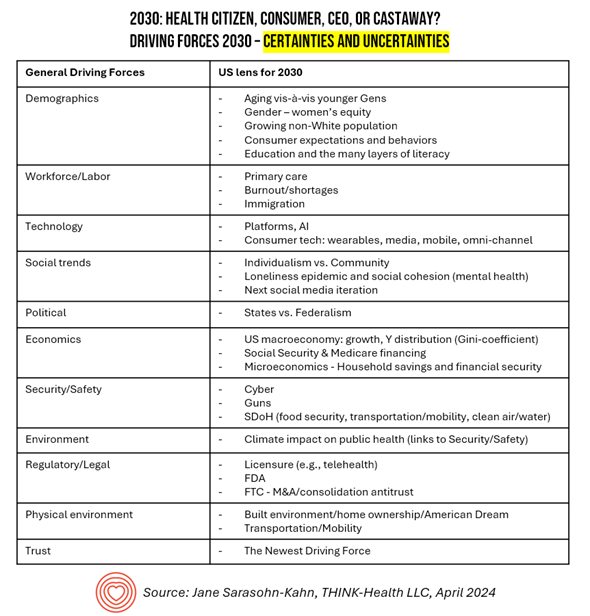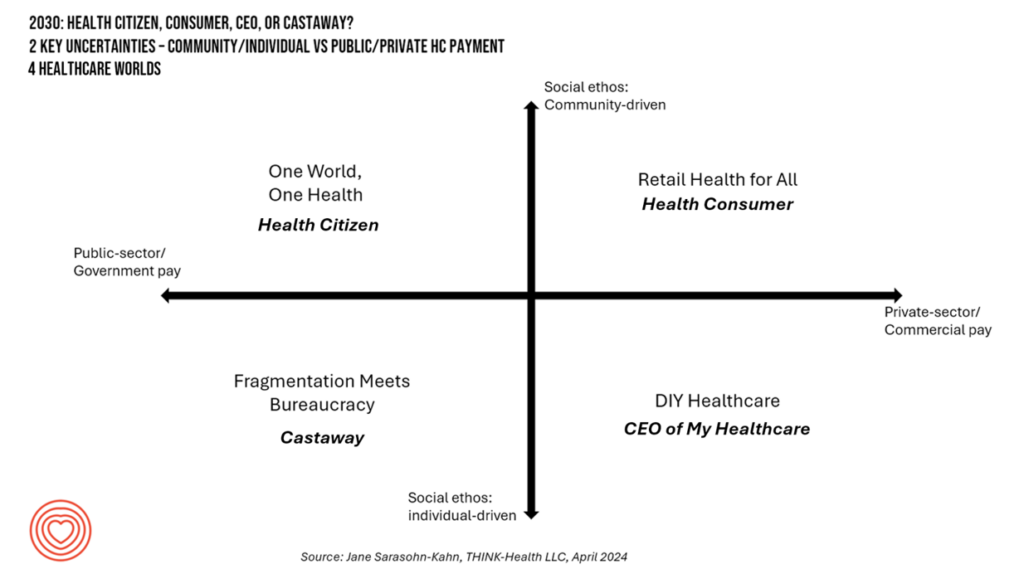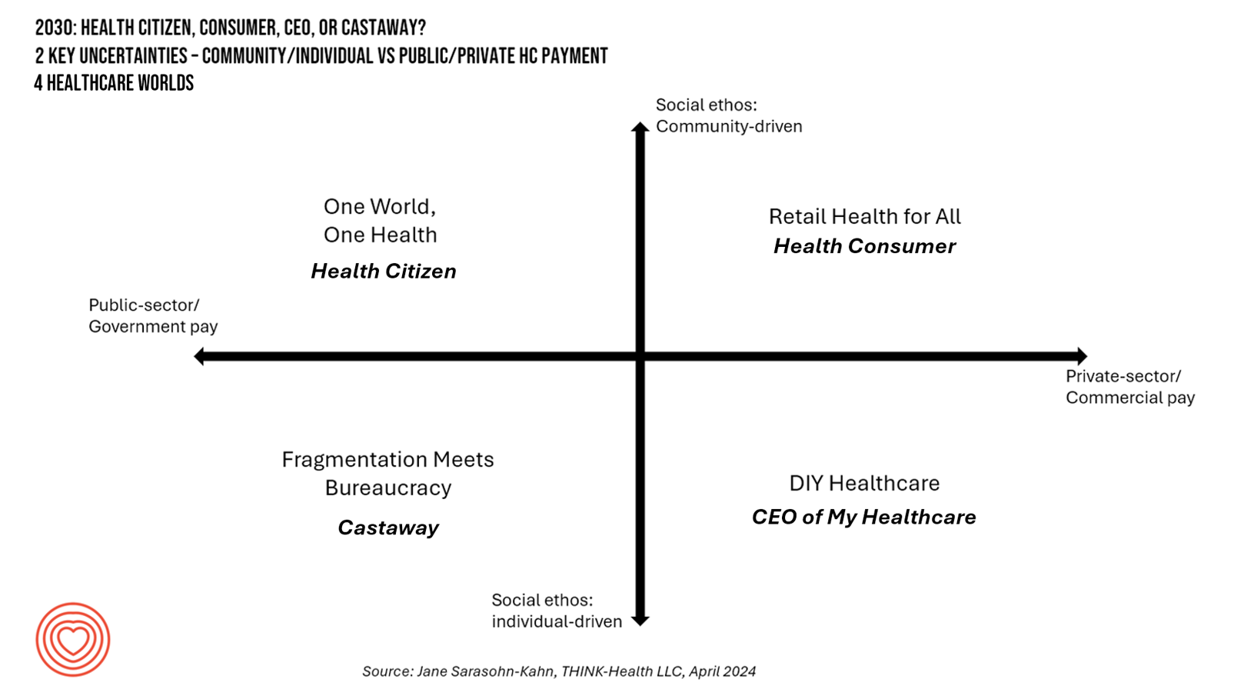In the past few years, what event or innovation has had the metaphorical impact of hitting you upside the head and disrupted your best-laid plans in health care? A few such forces for me have been the COVID-19 pandemic, the emergence of Chat-GPT, and Russia’s invasion of Ukraine.
That’s just three, and to be sure, there are several others that have compelled me to shift my mind-set about what I thought I knew-I-knew for my work with organizations spanning the health care ecosystem.
I’m a long-time practitioner of scenario planning, thanks to the early education at the side of Ian Morrison of Institute for the Future and colleagues there. In fact, I had had an earlier exposure to scenario planning in a first-job-out-of-undergraduate school working in the energy industry, cutting my teeth on the Shell Oil method of SP honed by Peter Schwartz (see his still-relevant and -resonant book, The Art of the Long View, to learn how Shell was among the only oil companies that didn’t get caught out when OPEC emerged as an oil price-setter back in 1973).
In health care, scenario planning is a must-have tool in your tool-box if you have any role in foresight in your job – whether providing a service in your community, planning the launch of a new molecular entity, or innovating a novel food product going direct-to-consumer for well-being and self-care.
In advance of a session I’m shepherding at the upcoming AHIP 2024 conference in Las Vegas, I developed scenarios about health care in 2030 asking who “we” will be then as patient-plan members?
In this quick blog-sized session on scenario planning, we’ll start with identifying the driving forces that will shape health care in 2030, then sort out what we know about these – those are certainties – and what we don’t yet know about the factors – which are uncertainties.
To create four alternative futures, I’ll select two of these driving forces that, to me, are the most important and impactful, and the most uncertain – to shape health care in the U.S. in 2030.
By picking these two, we “stretch” them on an x- and y-axis in “low” and “high” flavors, and then live inside each of the four quadrants to explore the health care stories for our person – the “noun” in our futures. That is our end-user customers, our clients, our members, our patients, caregivers – and “us.”

The Driving Forces for Health Care in 2030
Driving forces are the factors that shape a market space, and we can use the general list I show in the first column for virtually any industry we work in. For health care in 2030, I’ve thought about each driving force and then gotten more granular in the second column focusing a bit deeper on the factor and how it might play out in 2030.
For example, for Workforce and Labor, I think about the supply of primary care providers, clinician burnout, and immigration – all factors that will be very important in 2030, and all with different levels of uncertainty.
But with this driving force and most of the others, I’m pretty comfortable about my level of certainty about them vis-à-vis the criticality of the factors for 2030.
Pick Two and Meet Me in the Futures
The two that make me most nervous because they’re so bloody important, and for which I’m also quite uncertain, are these two:
- America’s social ethos on one end individualistic and at the other, community-driven; coupled with,
- Health care financing, thinking mostly public-sector driven versus private/commercial.
We know the real world in 2030 will be a combination and nuanced “reality.” But that isn’t why we do scenario planning, to “pick the right future.”
We do this exercise to immerse ourselves in the different worlds, each of which tease out different ways the driving forces could play out for the person—and then test our strategy (ies) against the alternatives to ensure we are covering our bases, strategically, tactically – to not get caught too-off-guard by surprises in the market. When we think through these different worlds and the factors shaping them, we are better prepared to deal with “stuff” that inevitably happens that can shift our world slightly, or blow it apart – like rushing about for PPE when supplies from Asia dried up in the second quarter of 2020. Just sayin’.
Here’s the 2×2 matrix of what my two driving force choices create for us to consider.

Welcome to 4 future health care worlds for 2030
Congratulations: you’ve made your way through the first half of this post looking into the 2030 futures setting the stage for patients as different personas depending on what that future holds.
Stay tuned for the second half of this two-part series here on Health Populi on April 17th which will detail the four possible futures and peoples’ prospects for being consumers, CEOs of their care, health citizens, or castaways.





 I'm in amazing company here with other #digitalhealth innovators, thinkers and doers. Thank you to Cristian Cortez Fernandez and Zallud for this recognition; I'm grateful.
I'm in amazing company here with other #digitalhealth innovators, thinkers and doers. Thank you to Cristian Cortez Fernandez and Zallud for this recognition; I'm grateful. Jane was named as a member of the AHIP 2024 Advisory Board, joining some valued colleagues to prepare for the challenges and opportunities facing health plans, systems, and other industry stakeholders.
Jane was named as a member of the AHIP 2024 Advisory Board, joining some valued colleagues to prepare for the challenges and opportunities facing health plans, systems, and other industry stakeholders.  Join Jane at AHIP's annual meeting in Las Vegas: I'll be speaking, moderating a panel, and providing thought leadership on health consumers and bolstering equity, empowerment, and self-care.
Join Jane at AHIP's annual meeting in Las Vegas: I'll be speaking, moderating a panel, and providing thought leadership on health consumers and bolstering equity, empowerment, and self-care.